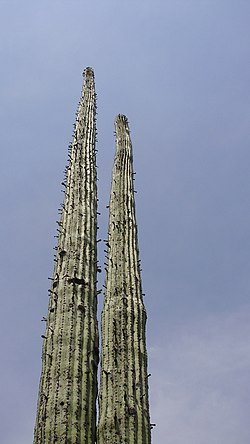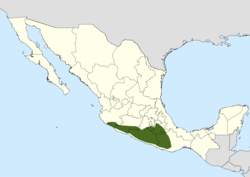Biology:Cephalocereus mezcalaensis
| Cephalocereus mezcalaensis | |
|---|---|

| |
| Scientific classification | |
| Kingdom: | Plantae |
| Clade: | Tracheophytes |
| Clade: | Angiosperms |
| Clade: | Eudicots |
| Order: | Caryophyllales |
| Family: | Cactaceae |
| Subfamily: | Cactoideae |
| Genus: | Cephalocereus |
| Species: | C. mezcalaensis
|
| Binomial name | |
| Cephalocereus mezcalaensis Bravo
| |

| |
| Synonyms | |
| |
Cephalocereus mezcalaensis is a species of Cephalocereus from Mexico.
Description
Cephalocereus mezcalaensis grows individually and reaches a height of 5 to 10 meters. The columnar, yellowish green shoots have a diameter of 13 to 40 centimeters. The 13 to 25 ribs are wide and angular. The one to four slightly flattened central spines are straight, dark and only slightly longer than the five to nine marginal spines. The expanded marginal spines are whitish to yellowish, darker at their tip and 0.8 to 2 centimeters long.
The funnel-shaped flowers often appear along the entire shoot. They are white to yellowish and purple and up to 5 centimeters long. Its pericarpel and flower tube are covered with tubercles with small scales and wool. The spherical to egg-shaped fruits are 3 to 4 centimeters long and covered with humps that carry perennial wool and thorns.[2]
Distribution
Cephalocereus mezcalaensis is found in the Mexican states of Colima, Guerrero, Jalisco, Michoacán, Morelos, Oaxaca and Puebla. It lives in tropical deciduous forests and xeric scrublands, on limestone soils, at elevations of 400 to 2000 m above sea level.[3]
Taxonomy
The first description was made in 1932 by Helia Bravo Hollis. The specific epithet mezcalaensis refers to the occurrence of the species in the valley of the Río Mezcala in the Mexican state of Guerrero. Nomenclature synonyms are Neobuxbaumia mezcalaensis (Bravo) Backeb. (1941), Neodawsonia mezcalaensis (Bravo) Backeb. (1941), Pilocereus mezcalaensis (Bravo) W.T.Marshall (1941) and Carnegiea mezcalaensis (Bravo) P.V.Heath (1992).
References
- ↑ Biología, Héctor Hernández (Instituto de; Group), Succulent Plants Specialist (2009-04-29). "The IUCN Red List of Threatened Species". IUCN Red List of Threatened Species. https://www.iucnredlist.org/species/152702/121545534. Retrieved 2023-10-31.
- ↑ Anderson, Edward F.; Eggli, Urs (2005) (in de). Das grosse Kakteen-Lexikon. Stuttgart (Hohenheim): Ulmer. ISBN 3-8001-4573-1.
- ↑ Neobuxbaumia mezcalaensis: Hernández, H.M., Cházaro, M. & Gómez-Hinostrosa, C., IUCN, 2009-04-29, p. 439, doi:10.2305/iucn.uk.2017-3.rlts.t152702a121545534.en
External links
Wikidata ☰ Q14955117 entry
 |



